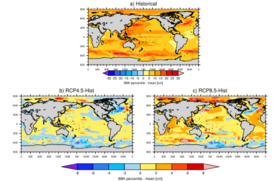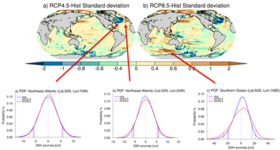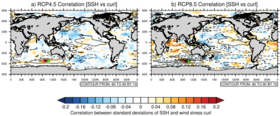Future shifts in Sea level Statistics- Implications with the MPI-GE
by S.D. Nandini-Weiss1, S. Ojha1,3, A. Köhl1, J.H. Jungclaus2 and D. Stammer1 1CEN/Universität Hamburg, 2 MPI Indian 3 Institute of Space and Technology, Kerala, India.



Information about impacts of future climate change on global and regional sea level variability, and the potential impact of extreme sea level on coastal risk management are scarce and a growing matter of concern. Future impacts can be investigated by analyzing sea level statistics. The main aims of our research is to use the Max Planck Institute Grand Ensemble (MPI-GE) simulations to estimate regional sea level variability by the end of the 21st century under two emission scenarios (RCP4.5 & 8.5) & shifts in the probability distribution statistics of skewness and kurtosis; both of which are indicative of the Gaussian nature or deviations thereof of sea level PDFs. Among the benefits of using a large ensemble created from a single climate model is that we can better capture the total variability from the ensemble spread and the variability in time.
The model’s tropical SSH variability shows a most pronounced deviation from Gaussian statistics, notably in the western and eastern tropical Pacific. By the end of 2100, SSH variability of the western tropical Pacific shows the tendency toward a more Gaussian variability linked with weaker zonal easterly wind stress pulses and thus reduced ENSO activity in the warm pool region. Globally, SSH variability changes in a complex pattern with some regions becoming less variable, e.g., off the eastern coast of the north American continent, while other regions become more variable in SSH, notably the Southern Ocean, and the North Pacific. In the North Atlantic, the enhanced west (decrease)-east (increase) gradient in the RCP8.5 SSH variability is related with changes in basin gyre circulation and the declining AMOC, with the effect of external forcing is dominating.
Our results suggest that sea level variability increases for the high-end scenario in some regions, e.g., Northwest Atlantic, North Pacific and the Southern Ocean, but declines for Northeast Atlantic. Most importantly, our study shows that the overall future global and regional projected sea level shifts in the mean and 99th percentiles toward higher values (in all scenarios); indicating increase in sea level extremes; which is vital for coastal adaptations under climate change. Key Points: Changes In future sea level variability in the North Atlantic and Southern Ocean can be linked to changes in regional wind stress and wind stress curl. Regionally, they result in a widening of the PDF, i.e., an increase in high-end numbers.
